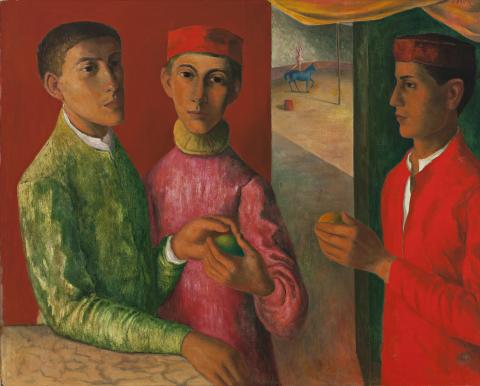THREE JUGGLERS, 1955
JUSTIN O’BRIEN
oil on canvas
56.0 x 69.5 cm
signed upper right: O’BRIEN
inscribed verso: JUSTIN O’BRIEN / ‘THE JUGGLERS’ / …
Society of Artists, Sydney
ICI Collection of Australian Art, Melbourne, acquired from the above in August 1958
Orica Collection, Melbourne, acquired from the above in 1998
Kerry Stokes Collection, Perth, acquired from the above in 2002
Art from the Kerry Stokes Collection, Sotheby's, Sydney, 26 August 2002, lot 504
Gould Galleries, Melbourne
Private collection, London
Society of Artists Spring Exhibition, Sydney, August 1958
Eagle, M., and Jones, J., A Story of Australian Painting, Macmillan Australia, Sydney, 1994, pl. 104, p. 247 (illus.)
Three Jugglers, 1955, was painted in Sydney at a time when Justin O’Brien and his peers were reaping the artistic rewards of greater accessibility to art historical knowledge. A product of the international outlook of Australian Modernism in the mid 20th century, Three Jugglers, as Mary Eagle and John Jones note in their seminal publication, A Story of Australian Painting, bears strong stylistic references to 15th century paintings of the Northern Italian Renaissance.1 Affordable international travel during the 20th century had ramifications for the Australian art world that should not to be underestimated. Young Australian artists working in a modern style could enjoy unfettered access to original masterpieces, integrating classical subject matter and techniques into their works. Within the Australian artistic community, Justin O’Brien’s euro-centrism was quite unique and was noticeable from the earliest of his works. With a rich colour palette, sharp geometric composition, and dramatic chiaroscuro, Three Jugglers provided O’Brien with the means to explore the stylistic possibilities of Renaissance techniques for himself.
Standing statically in the foreground of the painting are three young men, their serious countenances incongruous within the circus setting. Seeming to have almost no interaction between themselves, these young boys are fixed in elegant poses with solemn and emotionally distant expressions. The young man in profile on the right hand side of the painting holds a pose that is common in devotional portraits of the Renaissance (often depicted on the exterior panels of a religious narrative painting) holding his hands in a position of prayer. His costume and appearance is similar to that of della Francesca’s portrait of the Duke of Urbino in Florence’s Uffizi museum. Within his hands is held a ball, while the other is passed between his two companions. These juggling balls create a tangible link between these three sitters, and a visual cue drawing the eye toward the modern circus scene in the background. Compositionally, the insertion of a window through which the viewer can glimpse the big-top, is a device often employed during the Renaissance, the painting-within-a-painting creating an extension of the natural world to heighten the realism of the scene in the foreground.
In the early 1950s, O’Brien also drew inspiration from French modernist artists, Paul Cézanne, André Derain, and Pablo Picasso. His series of portraits of young men, many of whom were his students at Sydney’s Cranbrook School, have a particular affinity with Picasso’s paintings of harlequins and circus performers of his famous Rose Period (1901 – 1905). This subject material would provide O’Brien, as it had done for Picasso, with a pretext to explore colour, form and the psychological possibilities of portraiture. More poignant than the decorative theme would suggest, Three Jugglers is a sumptuous exploration into portraiture, capturing the sitters in their youthful navigation of self-expression.
1. Eagle, M., and Jones, J., The Story of Australian Painting, Pan MacMillan, Sydney, 1994, p. 244
LUCIE REEVES-SMITH
